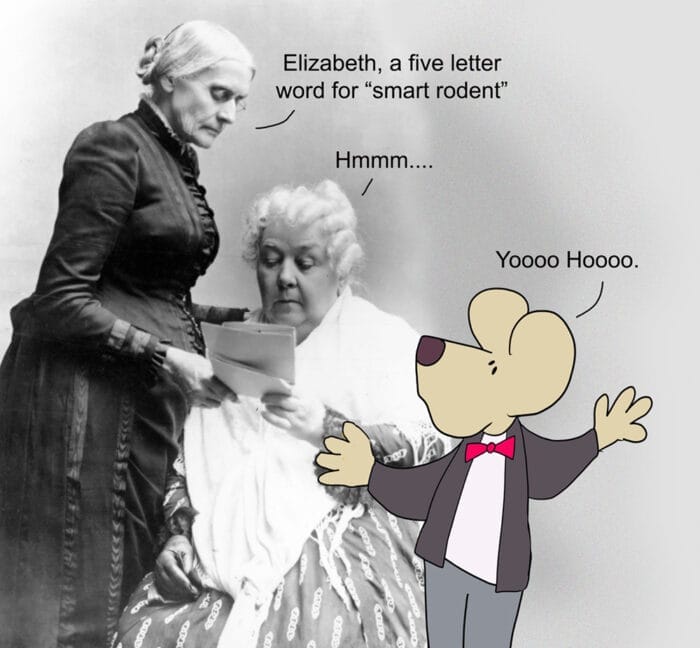Coins, and the faces that are on them. On this very date in 1978, the United States Congress approved the one-dollar coin which honors Susan B. Anthony. Yes, we know that good Susan B. spent her entire adult life fighting for women’s rights, specifically the right to vote.
But oftentimes, we don’t know the backstory, the things that took place, before her “important” life’s work took hold.
Susan was born in Adams, Massachusetts, on a Tuesday, and we know Tuesday’s child is full of grace. It was the 15th of February, in 1820, to be exact. Her father, Daniel Anthony, was an abolitionist and also temperance advocate. And, among other things, he was a Quaker. He was a wild child in the Quaker world, it seems, and he ran into problems with the traditional congregation. They had rebuked him for marrying a non-Quaker. If that weren’t enough, they then disowned him for allowing a dance school to operate in his home. But, despite being shunned on all accounts, he continued to attend Quaker meetings anyway. The history on him says he became even more radical in his beliefs, and I’m not quite sure what that means. I don’t know if the dance school was getting dicey, or what was going on.
Anyway, little Susan B.’s mother was named Lucy Read, and she was a Methodist. She may have been the “middle of the road” voice in the family and helped to raise the children in a more tolerant version of her husband’s religious tradition.
Yet, their father encouraged them all — both the girls and the boys — to be self-supporting. He taught them strong principles. All of them were given “responsibilities at an early age.” Again, I do not know what this entails. Is it like ‘taking out the trash’ and ‘doing the dishes’ responsibilities? Because I had those as a kid, and as far as I can tell, it had no effect on my drive to save humanity later in life, as it did with little Sue B. Perhaps some further research is due.
She was the second-oldest of seven kids. I like families with seven kids because of my own circumstance. And when she was born, she was just plain old Susan. As kids do, they horse around. And in her youth, she and her sisters responded to a “great craze for middle initials.” So they all added middle initials to their own names. Susan took on the “B.” as her middle initial. She had been named for her aunt Susan, who had married a man named Brownell. Yes, she took the “B,” but she never used the name Brownell herself, and did not like the name at all.
I always wonder how people “grow up” to be what they are, especially those so involved in doing magnanimous things, or those with incredible drive and determination. Well, her family shared a passion for social reform, it seems. Her brothers Daniel and Merritt moved all the way out to Kansas to support the anti-slavery movement there. Brother Merritt fought with John Brown against pro-slavery forces during the Bleeding Kansas crisis. And Brother Daniel found his voice by owning a newspaper. He also became the mayor of Leavenworth. And her sister Mary became a public school principal in Rochester, and a woman’s rights activist. I’m guessing the other three kids were slackers.
When Susan B. was six years old, her family moved to Battenville, New York, where her father managed a large cotton mill. He must have stuck with that for many years until misfortune hit. It happened when Susan B. was seventeen. She had been sent to a Quaker boarding school in Philadelphia. She found no happiness there. The environment was described as severe. But I mentioned a downturn. She was forced to end her studies after one term because her family was financially ruined during an economic slurry known as the Panic of 1837. They needed money and were forced to sell everything they owned at an auction. Thankfully for them, they had a rich uncle on their mother’s side. He bought most of their belongings and gave them right back to the family.
Susan B. would do work, mostly as a headmistress at an academy during early adulthood. Then, around 1849 (at the age of 29), with the full support of her family, she became highly involved in the pursuit of the suffrage and abolition movements. For the rest of her life, she worked tirelessly, becoming a “rock star” in the world of women’s rights. She lived almost entirely on fees she earned as a speaker.
And that is some of the backstory behind the face that’s engraved on the one-dollar coin. Spend it well.
=======
“Feminism is the radical notion that women are people.”
― Marie Shear
=========
“A feminist is anyone who recognizes the equality and full humanity of women and men.”
― Gloria Steinem
======
“Men should think twice before making widowhood women’s only path to power.”
― Gloria Steinem
=======
Flip the dollar, and if you get heads, you’ll know who she is.

